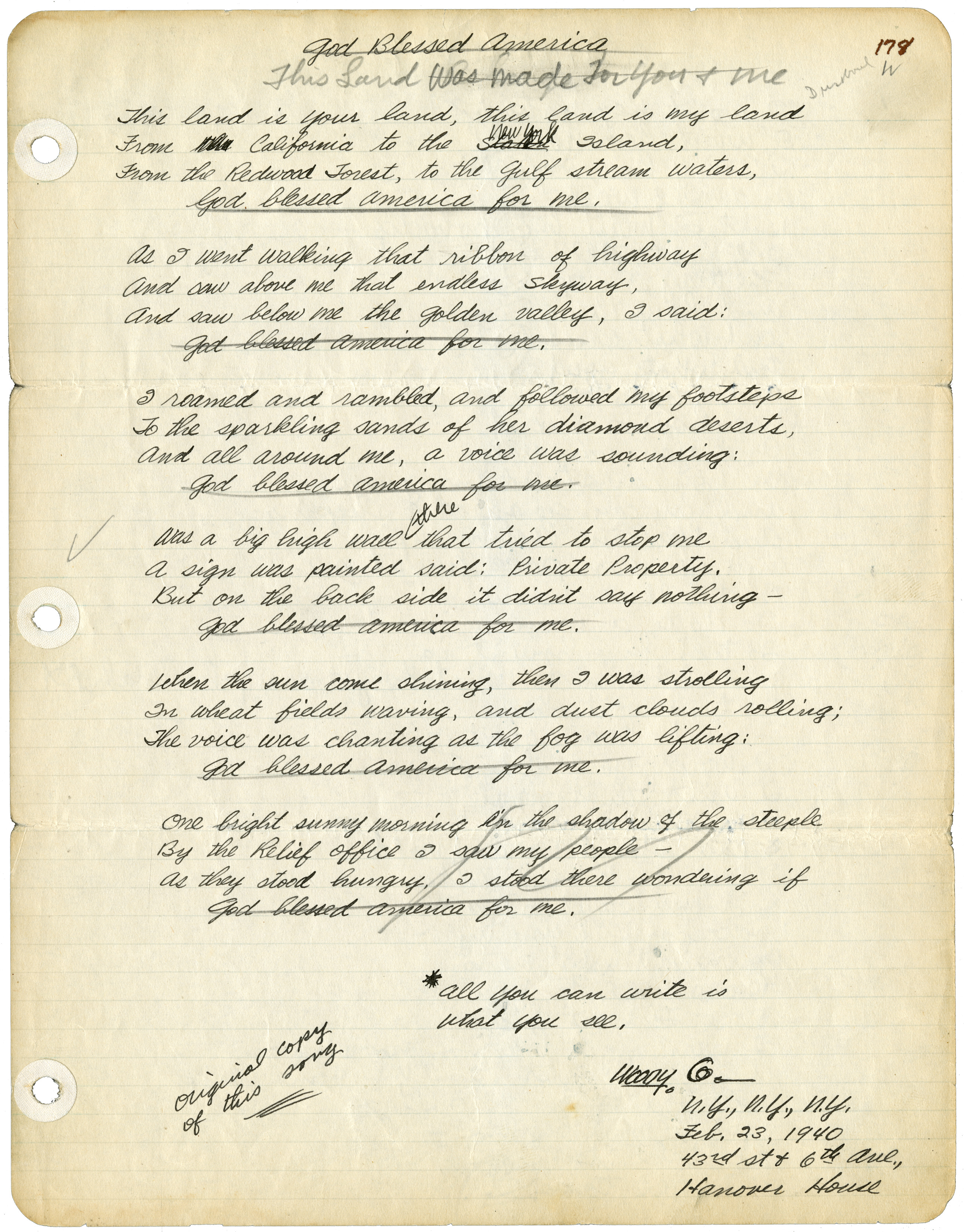The Lost Verses of “This Land is Your Land”
“All that you can write is what you can see” is written at the bottom of the original manuscript for what is now known as “This Land is Your Land.” Woody Guthrie’s seminal masterpiece started as six verses penned in cursive on a sheet of paper. The page contains various markups and lines crossed out; the bottom right corner is signed “Woody G.” with the date and location of what would go on to become one of the most definitive cultural artifacts in American history.
On February 23, 1940, Woody Guthrie was staying at the Hanover House on the corner of 43rd St. and 6th Ave. in New York City’s Times Square. The modest hotel was popular among transients that wandered to and from New York, and Woody had just arrived in the city a week prior after hitchhiking from California. Akin to his initial exodus from Oklahoma with his fellow Dust Bowl Okies, Guthrie’s journey to New York provided him with an invaluable look into the experiences of Americans in every corner of the country.
During the time of “This Land’s” conception, the Great Depression had ravished the American people for over a decade, leaving poor and working-class families in worsening states of disenfranchisement. Dust Bowl migrants like Guthrie found themselves struggling to find or keep employment. Meanwhile, news of an expanding war in Europe was being piped into radios across America. These wartime updates were often accompanied by Kate Smith’s rendition of Irving Berlin’s “God Bless America.”
Berlin originally wrote the song during the first World War. Twenty years later, the patriotic rallying cry was reimagined and revised as a call for nationalism while America stood on the brink of entering a second bloody conflict in Europe. And as Woody Guthrie traveled throughout the country, “God Bless America” began to dominate the airwaves and saturate radio stations nationwide. There was a concerted attempt to drum up a sense of patriotism among the American people to support an impending war effort. However, the America that Woody saw and experienced during his travels stood in stark contrast to the singular portrayal written in “God Bless America.”
The original title of what is now known as “This Land is Your Land” was “God Blessed America,” serving as a pointed commentary of Berlin’s song. In the manuscript, “God Blessed America for me,” appears at the bottom of each verse, but were then later crossed out. Additionally, two “lost” verses appear on the original manuscript that were eventually omitted in the 1951 official release of the song.
The fourth verse reads,
“There was a big high wall there that tried to stop me.
The sign was painted, said ‘Private Property.’
But on the backside, it didn’t say nothing.
This land was made for you and me.”
Woody’s first recording of “This Land” in 1944 featured a rendition that included this fourth verse. That recording had gone missing until it was uncovered some fifty years later in 1997. The sixth and final verse on the manuscript was never officially recorded.
It reads,
“One bright sunny morning in the shadow of the steeple,
by the relief office I saw my people.
As they stood hungry,
I stood there wondering if God blessed America for me.”
While on his travels, Woody Guthrie was able to soak in the immense grandiosity of America’s geographic landscape while also being a first-hand witness to the growing disillusionment of its people. With all the beauty America had to offer, there was also a deep struggle. These lost verses tell the full story of the things that he saw and, in context, can be seen more as a journal entry than a song of pure praise. Did “God Bless America” for everyone or just the lucky few?
Even though Guthrie’s lyrics represented the anxieties that many Americans felt during the time, there was still a prominent omission. The refrain, “this land was made for you and me,” was a call for unity among everyday Americans yet falls short of recognizing Indigenous rights to that very land. Guthrie was not wholly unaware of the Native American plight as seen in his later work and vocal solidarity, but the blind spot in “This Land,” has remained a point of critique.
In the early 1950s, the version of “This Land is Your Land” as we know it today became a sensation for the masses. It began to be published in school music textbooks across the nation, propelling it into the American psyche. Young Americans growing up in school would recite its famous lines for generations to come. The lyrics have transcended what was originally written down on that sheet of paper back in 1940, but we must view the song, just like Woody’s life, in its entirety.
Woody Guthrie was a mouthpiece for the experiences of everyday Americans, the good and the bad. Underneath the last verse, Woody wrote, “All that you can write is what you can see,” encouraging everyone to pay attention to what lies in front of us.
All works by Woody Guthrie © Woody Guthrie Publications, Inc. Used with permission.
More Blackwing Volume 223 Content:
Woody’s Life in Color – Blackwing Blog
Woody’s Notebooks – Blackwing Blog

